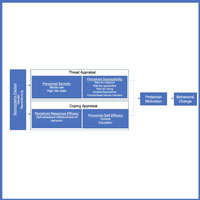Age differences in the relationship between threatening and coping mechanisms and preventive behaviors in the time of COVID-19 in the United States: Protection Motivation Theory

Submitted: August 8, 2020
Accepted: November 27, 2020
Published: January 14, 2021
Accepted: November 27, 2020
Abstract Views: 6006
PDF: 1022
HTML: 29
HTML: 29
Publisher's note
All claims expressed in this article are solely those of the authors and do not necessarily represent those of their affiliated organizations, or those of the publisher, the editors and the reviewers. Any product that may be evaluated in this article or claim that may be made by its manufacturer is not guaranteed or endorsed by the publisher.
All claims expressed in this article are solely those of the authors and do not necessarily represent those of their affiliated organizations, or those of the publisher, the editors and the reviewers. Any product that may be evaluated in this article or claim that may be made by its manufacturer is not guaranteed or endorsed by the publisher.
Similar Articles
- Claudia Capella, Carolina Gutiérrez, Loreto Rodrìguez, Camila Gòmez, Change during psychotherapy: the perspective of children and adolescents who have been sexually abused , Research in Psychotherapy: Psychopathology, Process and Outcome: Vol. 21 No. 1 (2018)
- Rosalba Di Biase, Chris Evans, Daniela Rebecchi, Flavia Baccari, Anna Saltini, Elena Bravi, Gaspare Palmieri, Fabrizio Starace, Exploration of psychometric properties of the Italian version of the Core Young Person’s Clinical Outcomes in Routine Evaluation (YP-CORE) , Research in Psychotherapy: Psychopathology, Process and Outcome: Vol. 24 No. 2 (2021): SPECIAL ISSUE "Working on dreams, from psychotherapy to neuroscience"
- Claudia Capella, Loreto Rodríguez, Estrella Azócar, Ximena Lama, Lucía Núñez, Daniela Águila, Camila Gomez, Macarena Espeleta, Vania Vasquez, Psychotherapeutic change in children and adolescents who have been sexually abused: a model from participants’ perspectives , Research in Psychotherapy: Psychopathology, Process and Outcome: Vol. 25 No. 1 (2022)
- Ana Nunes da Silva, Antònio Branco Vasco, Jeanne C. Watson, Alexithymia and emotional processing: a longitudinal mixed methods research , Research in Psychotherapy: Psychopathology, Process and Outcome: Vol. 21 No. 1 (2018)
- Lucia Nuñez, Sofía Fernández, Nicolle Alamo, Nick Midgley, Claudia Capella, Mariane Krause, The therapeutic relationship and change processes in child psychotherapy: a qualitative, longitudinal study of the views of children, parents and therapists , Research in Psychotherapy: Psychopathology, Process and Outcome: Vol. 25 No. 1 (2022)
- Kiran Boone, Kennedy M. Balzen, Carla Sharp, Impairment in personality functioning predicts young adult suicidal ideation and suicide attempt above and beyond depressive symptoms , Research in Psychotherapy: Psychopathology, Process and Outcome: Vol. 27 No. 3 (2024)
- Giovanna Esposito, Anna Sara Cutolo, Raffaella Passeggia, Silvia Formentin, Miguel Mario Gonçalves, Tracking change in group interventions: a further adaptation of the innovative moments coding system for groups , Research in Psychotherapy: Psychopathology, Process and Outcome: Vol. 25 No. 3 (2022): SPECIAL ISSUE: "Group psychotherapy: between settled benchmarks and new horizons"
- CV Vijayapriya, Rameshbabu Tamarana, Effectiveness of internet-delivered dialectical behavior therapy skills training on executive functions among college students with borderline personality traits: a non-randomized controlled trial , Research in Psychotherapy: Psychopathology, Process and Outcome: Vol. 26 No. 3 (2023)
- John S. Auerbach, The contributions of Sidney J. Blatt: a personal and intellectual biography , Research in Psychotherapy: Psychopathology, Process and Outcome: Vol. 20 No. 1 (2017)
- Alice Fiorini Bincoletto, Ludovica Zanini, Grazia Fernanda Spitoni, Vittorio Lingiardi, Negative and positive ageism in an Italian sample: how ageist beliefs relate to epistemic trust, psychological distress, and well-being , Research in Psychotherapy: Psychopathology, Process and Outcome: Vol. 26 No. 2 (2023)
You may also start an advanced similarity search for this article.

 https://doi.org/10.4081/ripppo.2020.485
https://doi.org/10.4081/ripppo.2020.485





